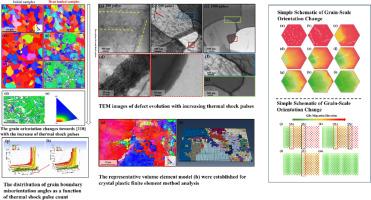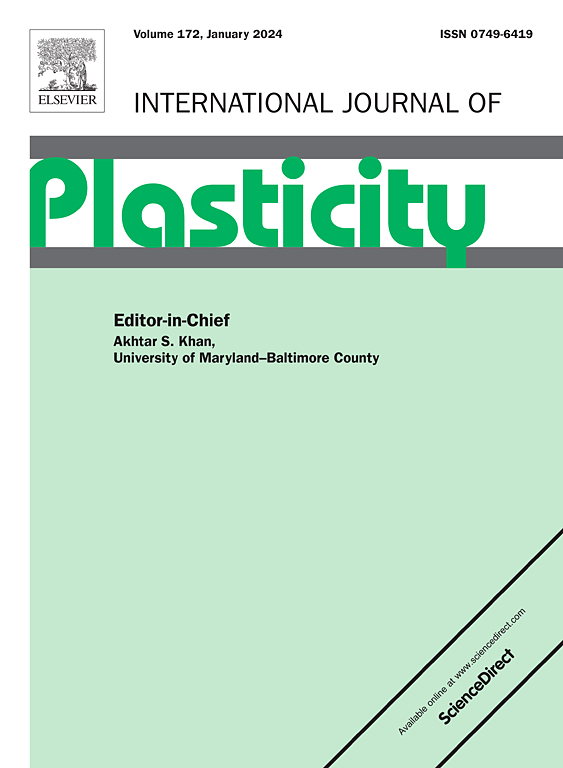Role of thermal stress-driven dislocation and low-angle grain boundary migration in surface plastic deformation and grain orientation evolution of tungsten under thermal shock
IF 9.4
1区 材料科学
Q1 ENGINEERING, MECHANICAL
引用次数: 0
Abstract
This study reveals that thermal fatigue loading (transient thermal shock), similar to that in fusion environments, can serve as a surface processing technique for BCC metals. Regions with a {110} grain orientation can be selectively achieved in varying sizes and locations on the sample surface. Furthermore, our experiments confirm that the specific localized orientation transformation obtained through this method exhibits certain high-temperature stability at 1573 K (above the recrystallization temperature of tungsten). The experiment employed a 0.25 GW/m² high-energy pulsed electron beam for 1 ms to cyclically load the tungsten surface, simulating edge localized mode events in fusion conditions. It was found that tungsten exhibited significant surface grain orientation transformation (distinct {110} grain orientation) under low strain (∼ 1 %) after transient thermal shocks, a phenomenon rarely mentioned in studies of thermal shock on fusion reactor divertor materials. Microstructure characterization results suggest that this localized orientation transformation, induced by minor surface damage, primarily results from the generation, movement, and evolution of dislocations into subgrain and low-angle grain boundaries. The cyclic accumulation of the migration of kink-like subgrain/low-angle grain boundaries under transient thermal stress at high temperatures drives this process. Subsequently, crystal plasticity finite element method simulations based on dislocation slip were conducted to study the surface grain orientation transformation of tungsten under compressive thermal stress. This predictive capability provides valuable guidance for understanding the service conditions of fusion reactor divertor materials. Furthermore, we propose that cyclic transient thermal shocks can serve as an effective surface processing technique for metals, enabling the formation of specific localized grain orientations.


热应力驱动的位错和低角度晶界迁移在热冲击下钨表面塑性变形和晶粒取向演化中的作用
本研究表明,热疲劳加载(瞬态热冲击),类似于熔合环境,可以作为BCC金属的表面加工技术。具有{110}晶粒取向的区域可以选择性地在样品表面的不同尺寸和位置上实现。此外,我们的实验证实,通过该方法获得的特定局部取向转变在1573 K(高于钨的再结晶温度)时具有一定的高温稳定性。实验采用0.25 GW/m²高能脉冲电子束循环加载钨表面,模拟聚变条件下的边缘局域模式事件。发现钨在瞬态热冲击后的低应变(~ 1%)下表现出明显的表面晶粒取向转变(明显的{110}晶粒取向),这一现象在聚变反应堆转向器材料的热冲击研究中很少提及。微观结构表征结果表明,这种由轻微表面损伤引起的局部取向转变主要是由位错在亚晶界和低角度晶界的产生、移动和演化引起的。高温瞬态热应力作用下扭结状亚晶/低角度晶界迁移的循环积累驱动了这一过程。随后,采用基于位错滑移的晶体塑性有限元模拟方法,研究了压缩热应力作用下钨的表面晶粒取向转变。这种预测能力为理解聚变反应堆导流器材料的使用状况提供了有价值的指导。此外,我们提出循环瞬态热冲击可以作为一种有效的金属表面加工技术,使特定局部晶粒取向的形成成为可能。
本文章由计算机程序翻译,如有差异,请以英文原文为准。
求助全文
约1分钟内获得全文
求助全文
来源期刊

International Journal of Plasticity
工程技术-材料科学:综合
CiteScore
15.30
自引率
26.50%
发文量
256
审稿时长
46 days
期刊介绍:
International Journal of Plasticity aims to present original research encompassing all facets of plastic deformation, damage, and fracture behavior in both isotropic and anisotropic solids. This includes exploring the thermodynamics of plasticity and fracture, continuum theory, and macroscopic as well as microscopic phenomena.
Topics of interest span the plastic behavior of single crystals and polycrystalline metals, ceramics, rocks, soils, composites, nanocrystalline and microelectronics materials, shape memory alloys, ferroelectric ceramics, thin films, and polymers. Additionally, the journal covers plasticity aspects of failure and fracture mechanics. Contributions involving significant experimental, numerical, or theoretical advancements that enhance the understanding of the plastic behavior of solids are particularly valued. Papers addressing the modeling of finite nonlinear elastic deformation, bearing similarities to the modeling of plastic deformation, are also welcomed.
 求助内容:
求助内容: 应助结果提醒方式:
应助结果提醒方式:


